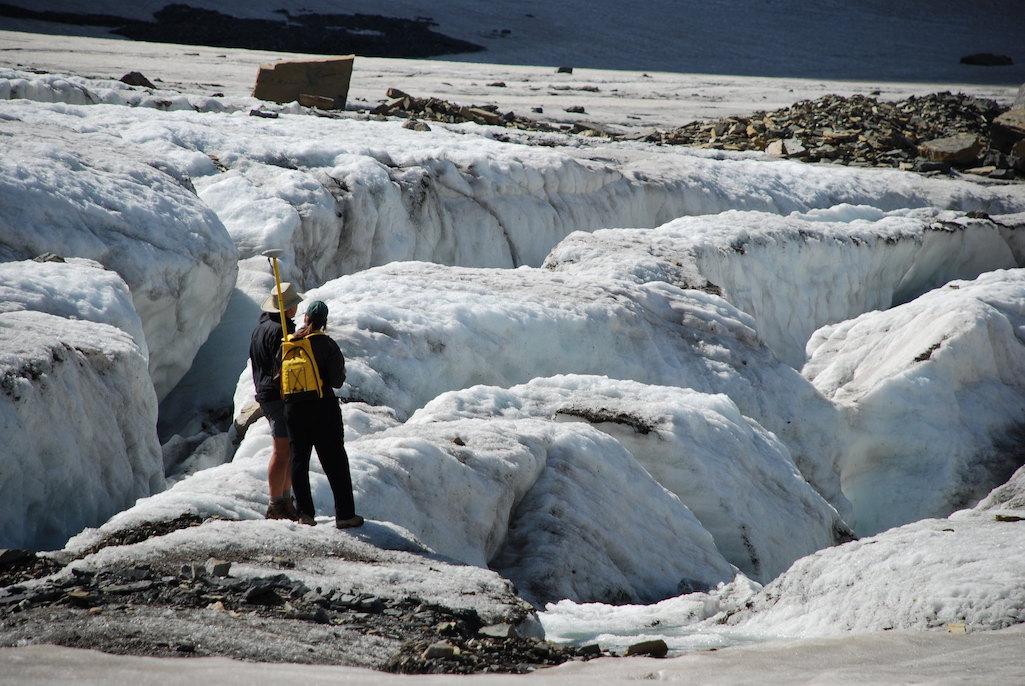
Measuring the terminus of Grinnell Glacier at Glacier National Park. Glacier is one of five parks that have dominated peer-reviewed research since 1970, according to a review/NPS file
Though the National Park System stretches from the ocean floor to the roof of Denali, the bulk of peer-reviewed research conducted in the parks is focused on just five parks, an analysis by North Carolina State researchers claims.
Across the park system and its more than 400 units exist thick kelp forests, coral reefs both healthy and ill, prey-predator relationships, climate-change impacts and adaptations, social science topics, and myriad elements of nature that hold undiscovered secrets. Yet just five parks dominated the nearly 7,000 peer-reviewed studies conducted since 1970, they said.
“Looking at the data was a surprise and perhaps a wake-up call,” said the study’s lead author Jelena Vukomanovic, assistant professor of parks, recreation and tourism management at NC State. “Overall, there’s more research being published than ever before, but we’re actually seeing a decline in publications of research conducted in the national parks.”
Vukomanovic and her team used the Web of Science database to analyze academic journal articles on national parks published between 1970 and 2018. The researchers focused on 59 designated national parks, excluded research on three newly established parks, and did not include reports published outside of peer-reviewed journals.
They found more than half of all studies since 1970 have focused on five national parks – the parks that see the greatest number of visitors per year. Yellowstone National Park accounted for 36.2 percent of studies; Everglades National Park was involved with 6.8 percent; Great Smoky Mountains National Park accounted for 6.2 percent; Glacier National Park represented 5.6 percent; and Yosemite National Park was the background for 5.3 percent of the studies.
“We need to understand that this is the context behind the conclusions we come to about our landscapes,” study co-author Josh Randall, graduate student in parks, recreation and tourism management at NC State, said in a release announcing their conclusions. “Many of the findings – and their management implications – that we may apply broadly come from a small number of parks.”
The location of parks near research universities wasn’t necessarily linked to the amount of published research on them.
“We know that well-funded researchers can travel to interesting places that have unique phenomena,” Vukomanovic said. “We found some relatively understudied parks are close – within a day trip distance – from a lot of research universities. This is a call for future work on the drivers of research, which could help both park and university administrators identify and address barriers.”
More than half of studies were conducted in parks in northwestern forested mountains. Seventeen percent of studies were done in North American deserts, 10 percent were in eastern temperate forests, tropical wet forests represented 7 percent of studies and marine West Coast forests were at 6 percent.
“The national parks of the east represent extraordinary biodiversity and cultural heritage,” Vukomanovic said. “How can we bolster research activity there?”
Among the team's findings:
- Life sciences research – and ecology and evolutionary biology studies in particular – made up the majority of park research, representing 60 percent of total publications.
- Physical sciences and mathematics research made up 25 percent of studies, with the largest share of research in that field going to the earth sciences.
- Social and behavioral science research made up 8 percent of studies;
- Engineering made up 3 percent;
- And education and multidisciplinary research made up 3 percent.
- The arts and humanities represented less than 1 percent of total research.
The study, Research Trends In U.S. National Parks, The World’s ‘Living Laboratories, was published online in Conservation Science and Practice on March 30, 2021.



Comments
Nomenclature myopia. Indiana Dunes National Park has long been the subject of research and would be on this list expect it was a National Lakeshore until a few years ago.
And, also, commentary myopia. The headline, I believe, avoided absolute statements and mentioned terms like "most". The percentages mentioned are nowhere near 100%.
The article states: "They found more than half of all studies since 1970 have focused on five national parks - the parks that see the greatest number of visitors per year." That was followed by the 5 parks and their percentages.
Those percenages add up to 60.1%, which qualifies as "most." That's all that's required, not that they add up to 100%.
The point is that 60% of all peer reviewed studies take place in only 5 parks. Taking the numbers one step further 85% of all physical and life science are inside that 60 %. if you use geophysical characteristics of those 5 parks we are making landscape assumptions based upon those from one swamp 3 northwestern mountainous areas and 1 mountainous area in the Southeast. It brings about the question of are We making landscaping decisions in Gettysburg, Arcadia or Isle Royal based on those studies? Secondly, it touches on the further possibility that peer reviewed studies are in short supply.